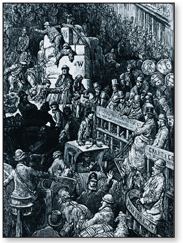Population Growth
 What was Malthus's view of population growth?
What was Malthus's view of population growth?
In 1798, English economist Thomas Malthus noted that humans were being born faster than people were dying, causing overcrowding, as shown in Figure 16–7.  Malthus reasoned that if the human population grew unchecked, there wouldn't be enough living space and food for everyone. The forces that work against population growth, Malthus suggested, include war, famine, and disease.
Malthus reasoned that if the human population grew unchecked, there wouldn't be enough living space and food for everyone. The forces that work against population growth, Malthus suggested, include war, famine, and disease.
Darwin realized that Malthus's reasoning applied even more to other organisms than it did to humans. A maple tree can produce thousands of seeds each summer. One oyster can produce millions of eggs each year. If all the descendants of almost any species survived for several generations, they would overrun the world. Obviously, this doesn't happen. Most offspring die before reaching maturity, and only a few of those that survive manage to reproduce.
Why was this realization so important? Darwin had become convinced that species evolved. But he needed a mechanism—a scientific explanation based on a natural process—to explain how and why evolution occurred. When Darwin realized that most organisms don't survive and reproduce, he wondered which individuals survive … and why.

FIGURE 16–7 Overcrowding in London A nineteenth-century engraving shows the crowded conditions in London during Darwin's time. Relate Cause and Effect According to Malthus, what would happen if the population of London continued to grow?
Artificial Selection
 How is inherited variation used in artificial selection?
How is inherited variation used in artificial selection?
To find an explanation for change in nature, Darwin studied change produced by plant and animal breeders. Those breeders knew that individual organisms vary—that some plants bear larger or smaller fruit than average for their species, that some cows give more or less milk than others in their herd. They told Darwin that some of this variation could be passed from parents to offspring and used to improve crops and livestock.
Quick Lab
GUIDED INQUIRY
Variation in Peppers

1 Obtain a green, yellow, red, or purple bell pepper.
2 Slice open the pepper and count the number of seeds it contains.
3 Compare your data with the data of other students who have peppers of a different color.

Calculate Find the average (mean) number of seeds in your class's peppers. Then determine by how much the number of seeds in each pepper differs from the mean number.

Pose Questions Think of the kinds of variations among organisms that Darwin observed. If Darwin had seen your data, what questions might he have asked?
Analyze and Conclude
Table of Contents
- Formulas and Equations
- Applying Formulas and Equations
- Mean, Median, and Mode
- Estimation
- Using Measurements in Calculations
- Effects of Measurement Errors
- Accuracy
- Precision
- Comparing Accuracy and Precision
- Significant Figures
- Calculating With Significant Figures
- Scientific Notation
- Calculating With Scientific Notation
- Dimensional Analysis
- Applying Dimensional Analysis




